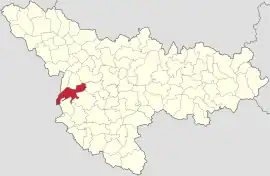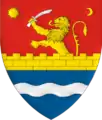Uivar | |
|---|---|
 Coat of arms | |
 Location in Timiș County | |
 Uivar Location in Romania | |
| Coordinates: 45°39′N 20°54′E / 45.650°N 20.900°E | |
| Country | Romania |
| County | Timiș |
| Established | 1811 |
| Government | |
| • Mayor (2020–2024) | Bogdan Săvulescu[1] (PMP) |
| Area | 97.1 km2 (37.5 sq mi) |
| Population (2021-12-01)[3] | 2,471 |
| • Density | 25/km2 (66/sq mi) |
| Time zone | EET/EEST (UTC+2/+3) |
| Postal code | 307445–307451 |
| Vehicle reg. | TM |
| Website | www |
Uivar (Hungarian: Újvár; German: Neuburg an der Bega) is a commune in Timiș County, Romania. It is composed of four villages: Pustiniș, Răuți, Sânmartinu Maghiar and Uivar (commune seat). Two other villages, Otelec and Iohanisfeld, which had been part of Uivar commune since 1968, were split off in 2008 to form Otelec commune.[4]
Name
| Romanian | Hungarian | German | Serbian |
|---|---|---|---|
| Pustiniș | Öregfalu | Pustinisch | |
| Răuți [Aurelhaza] | Aurélháza | Aurelheim or Rautendorf | |
| Sânmartinu Maghiar | Magyarszentmárton | Ungarisch St. Martin | Мађарски Семартон/Mađarski Semarton |
| Uivar | Újvár | Neuburg an der Bega |
History
Remains of Neolithic, Daco-Roman and medieval settlements were discovered on the territory of the commune. Archaeological excavations here revealed a Neolithic settlement from the 5th millennium BC that belongs to the Vinča culture.[5]
The first recorded mention of Uivar dates from 1811, when 50 German families were colonized here.[6][7] Each family then received 32 jugers of arable land. In 1851 a new wave of colonization took place, this time with Hungarians from the Szeged area and Germans. The village then became German-Hungarian, but over time the Hungarian element dissipated, leaving an overwhelming majority of Germans. After World War II, their number began to decline sharply and they were gradually replaced by Romanians. Today the village is mostly Romanian.
Demographics
Uivar had a population of 2,453 inhabitants at the 2011 census, down 10% from the 2002 census. Most inhabitants are Romanians (73.79%), larger minorities being represented by Hungarians (16.06%) and Roma (4.65%). For 4.4% of the population, ethnicity is unknown.[8] By religion, most inhabitants are Orthodox (56.34%), but there are also minorities of Roman Catholics (20.67%), Greek Catholics (12.19%) and Pentecostals (4.53%). For 4.4% of the population, religious affiliation is unknown.[9]
| Census[10] | Ethnic composition | |||||
|---|---|---|---|---|---|---|
| Year | Population | Romanians | Hungarians | Germans | Roma | Serbs |
| 1880 | 3,928 | 684 | 1,730 | 1,487 | – | 20 |
| 1890 | 4,884 | 704 | 1,709 | 2,407 | – | 47 |
| 1900 | 5,109 | 770 | 1,766 | 2,390 | – | 168 |
| 1910 | 4,925 | 868 | 1,895 | 2,075 | – | 59 |
| 1920 | 1,964[lower-alpha 1] | 22 | 1,517 | 418 | – | – |
| 1930 | 4,889 | 942 | 1,934 | 1,922 | 56 | 29 |
| 1941 | 4,610 | 868 | 1,807 | 1,823 | – | – |
| 1956 | 4,620 | – | – | – | – | – |
| 1966 | 4,128 | 2,035 | 1,404 | 657 | 5 | 26 |
| 1977 | 3,525 | 1,988 | 1,052 | 417 | 51 | 12 |
| 1992 | 2,687 | 1,818 | 673 | 62 | 122 | 9 |
| 2002 | 2,716 | 1,946 | 567 | 38 | 147 | 7 |
| 2011 | 2,453 | 1,810 | 394 | 17 | 114 | 5 |
Notes
- ↑ Data on the populations of Pustiniș and Uivar missing
References
- ↑ "Results of the 2020 local elections". Central Electoral Bureau. Retrieved 16 June 2021.
- ↑ "Informații generale". Primăria comunei Uivar.
- ↑ "Populaţia rezidentă după grupa de vârstă, pe județe și municipii, orașe, comune, la 1 decembrie 2021" (XLS). National Institute of Statistics.
- ↑ "Lege privind înființarea comunei Otelec, prin reorganizarea comunei Uivar, județul Timiș" (PDF). Camera Deputaților.
- ↑ Luca, Sabin Adrian (2006). Descoperiri arheologice din Banatul românesc: repertoriu (PDF). Alba Iulia: Altip. pp. 261–262. ISBN 973-7724-84-4.
- ↑ Crețan, Remus (2006). Dicționar toponimic și geografico-istoric al localităților din județul Timiș. Timișoara: Editura Universității de Vest. p. 151. ISBN 973-7608-65-8.
- ↑ Lotreanu, Ioan (1935). Monografia Banatului. Timișoara: Institutul de Arte Grafice „Țara”. p. 429.
- 1 2 "Tab8. Populația stabilă după etnie – județe, municipii, orașe, comune". Institutul Național de Statistică.
- 1 2 "Tab13. Populația stabilă după religie – județe, municipii, orașe, comune". Institutul Național de Statistică.
- ↑ Varga, E. Árpád. "Temes megye településeinek etnikai (anyanyelvi/nemzetiségi) adatai 1880-2002" (PDF).
